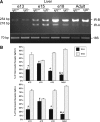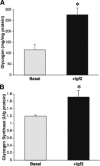Insulin-like growth factor 2 and the insulin receptor, but not insulin, regulate fetal hepatic glycogen synthesis
- PMID: 20032056
- PMCID: PMC2817628
- DOI: 10.1210/en.2009-0705
Insulin-like growth factor 2 and the insulin receptor, but not insulin, regulate fetal hepatic glycogen synthesis
Abstract
Whether insulin or IGFs regulate glycogen synthesis in the fetal liver remains to be determined. In this study, we used several knockout mouse strains, including those lacking Pdx-1 (pancreatic duodenal homeobox-1), Insr (insulin receptor), and Igf2 (IGF-II) to determine the role of these genes in the regulation of fetal hepatic glycogen synthesis. Our data show that insulin deficiency does not alter hepatic glycogen stores, whereas Insr and Igf2 deficiency do. We found that both insulin receptor isoforms (IR-A and IR-B) are present in the fetal liver, and their expression is gestationally regulated. IR-B is highly expressed in the fetal liver; nonetheless, the percentage of hepatic IR-A isoform, which binds Igf2, was significantly higher in the fetus than the adult. In vitro experiments demonstrate that Igf2 increases phosphorylation of hepatic Insr, insulin receptor substrate-2, and Akt proteins and also the activity of glycogen synthase. Igf2 ultimately increased glycogen synthesis in fetal hepatocytes. This increase could be blocked by the phosphoinositide 3-kinase inhibitor LY294008. Taken together, we propose Igf2 as a major regulator of fetal hepatic glycogen metabolism, the insulin receptor as its target receptor, and phosphoinositide 3-kinase as the signaling pathway leading to glycogen formation in the fetal liver.
Figures





Similar articles
-
Placental glycogen stores are increased in mice with H19 null mutations but not in those with insulin or IGF type 1 receptor mutations.Placenta. 2009 Aug;30(8):693-9. doi: 10.1016/j.placenta.2009.05.004. Epub 2009 Jun 13. Placenta. 2009. PMID: 19524295 Free PMC article.
-
Prevalent role of the insulin receptor isoform A in the regulation of hepatic glycogen metabolism in hepatocytes and in mice.Diabetologia. 2016 Dec;59(12):2702-2710. doi: 10.1007/s00125-016-4088-z. Epub 2016 Sep 7. Diabetologia. 2016. PMID: 27600278
-
Regulation of hepatic glycogen in the insulin-like growth factor II-deficient mouse.Endocrinology. 1999 Mar;140(3):1442-8. doi: 10.1210/endo.140.3.6602. Endocrinology. 1999. PMID: 10067873
-
Targeted gene mutations define the roles of insulin and IGF-I receptors in mouse embryonic development.J Pediatr Endocrinol Metab. 1999 Jul-Aug;12(4):475-85. doi: 10.1515/jpem.1999.12.4.475. J Pediatr Endocrinol Metab. 1999. PMID: 10417963 Review.
-
How does insulin stimulate glycogen synthesis?Biochem Soc Symp. 1978;(43):69-95. Biochem Soc Symp. 1978. PMID: 219866 Review.
Cited by
-
Systemic and local lipid adaptations underlie regeneration in Drosophila melanogaster and Ambystoma mexicanum.NPJ Regen Med. 2024 Oct 29;9(1):33. doi: 10.1038/s41536-024-00375-x. NPJ Regen Med. 2024. PMID: 39472660 Free PMC article.
-
Prospective association of fetal liver blood flow at 30 weeks gestation with newborn adiposity.Am J Obstet Gynecol. 2017 Aug;217(2):204.e1-204.e8. doi: 10.1016/j.ajog.2017.04.022. Epub 2017 Apr 20. Am J Obstet Gynecol. 2017. PMID: 28433734 Free PMC article.
-
Chorionic somatomammotropin RNA interference alters fetal liver glucose utilization.J Endocrinol. 2020 Dec;247(3):251-262. doi: 10.1530/JOE-20-0375. J Endocrinol. 2020. PMID: 33108344 Free PMC article.
-
Hypoxia impairs blood glucose homeostasis in naked mole-rat adult subordinates but not queens.J Exp Biol. 2024 May 15;227(10):jeb247537. doi: 10.1242/jeb.247537. Epub 2024 May 21. J Exp Biol. 2024. PMID: 38680085 Free PMC article.
-
Potent inhibition of angiogenesis by the IGF-1 receptor-targeting antibody SCH717454 is reversed by IGF-2.Mol Cancer Ther. 2012 Mar;11(3):649-59. doi: 10.1158/1535-7163.MCT-11-0575. Epub 2011 Dec 21. Mol Cancer Ther. 2012. PMID: 22188815 Free PMC article.
References
-
- Simoni RD, Hill RL, Vaughan M 2002 The discovery of insulin: the work of Frederick Banting and Charles Best. J Biol Chem 277:31–32
-
- Sperling M 1994 Carbohydrate metabolism: insulin and glucagons. In: Tulchinsky D, Little AB, eds. Maternal-fetal endocrinology. 2nd ed. Philadelphia: W. B. Saunders Co.; 380–400
-
- Margolis RN, Seminara D 1988 Glycogen metabolism in late gestation in fetuses of maternal diabetic rats. Biol Neonate 54:133–143 - PubMed
-
- Lopez MF, Dikkes P, Zurakowski D, Villa-Komaroff L, Majzoub J 1999 Regulation of hepatic glycogen in the insulin-like growth factor-deficient mouse. Endocrinology 140:1442–1448 - PubMed
-
- Menon RK, Sperling MA 1991 Role of insulin in the fetus. Indian J Pediatr 58:21–35 - PubMed
Publication types
MeSH terms
Substances
Grants and funding
LinkOut - more resources
Full Text Sources
Medical
Molecular Biology Databases
Research Materials
Miscellaneous

